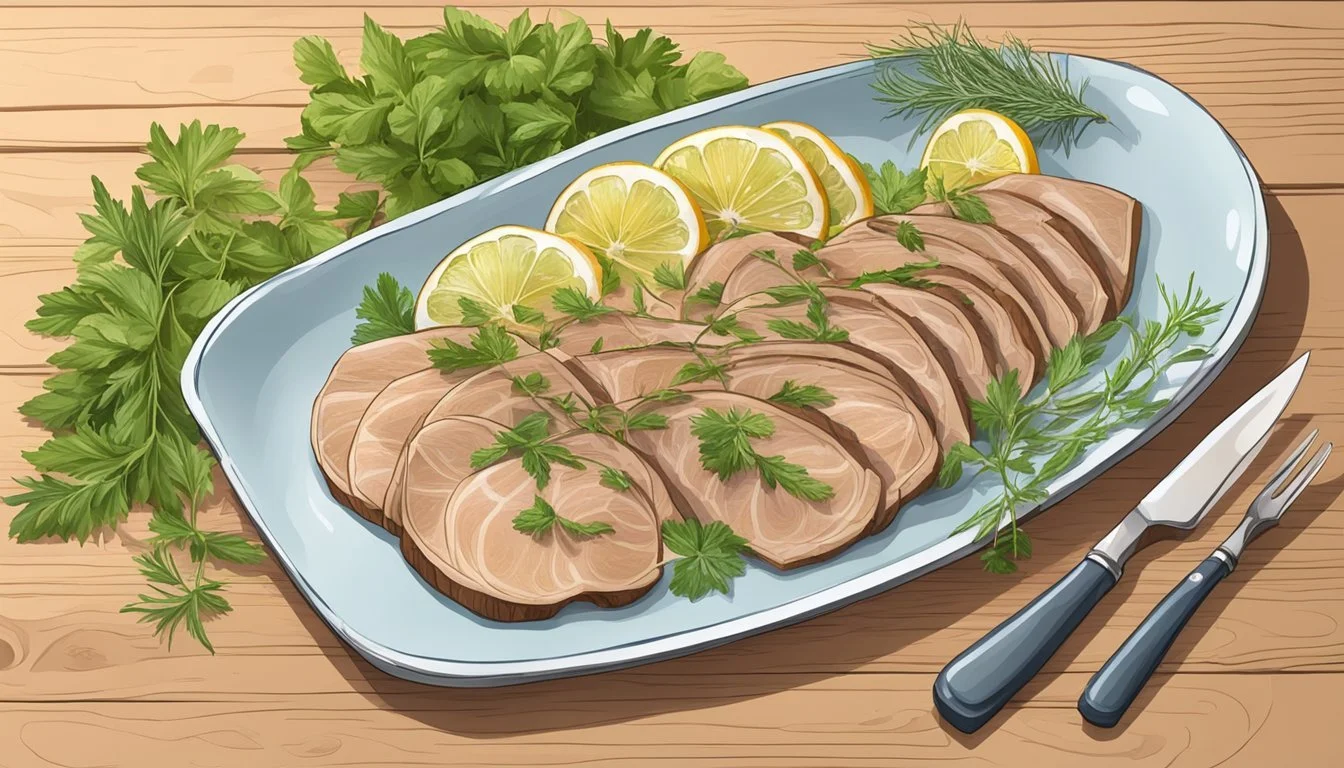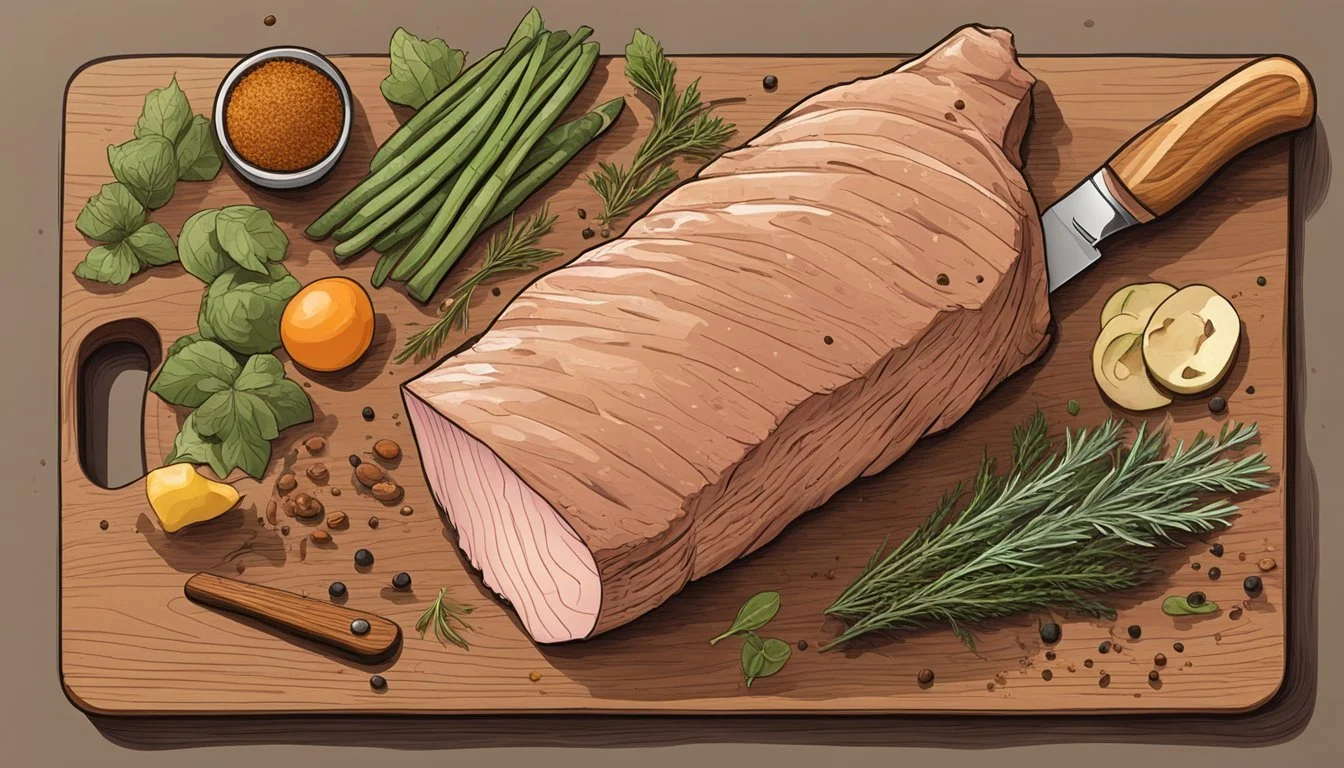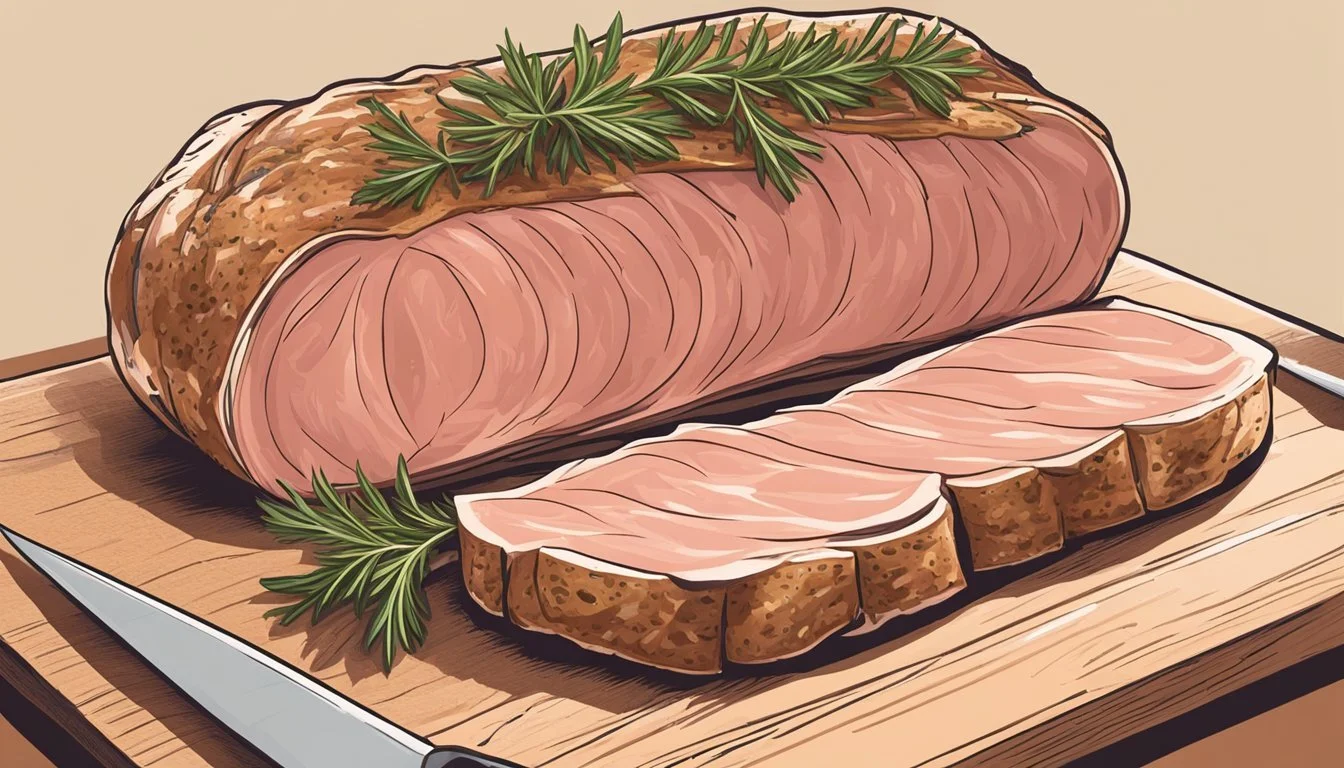Lonzino (Pork Loin) 101
The Essentials for Novices
Lonzino is a traditional Italian charcuterie made from dry-cured pork loin. This delicacy is appreciated for its rich flavor and firm texture, a result of the meticulous curing process it undergoes. Beginners interested in the art of charcuterie (What wine goes well with charcuterie?) will find lonzino an excellent starting point due to its relatively simple preparation and lower risk compared to other cured meats.
To create lonzino, one starts with a quality piece of pork loin and a precise amount of salt for curing. The process involves coating the meat evenly with a cure that typically includes salt, sugar, and a blend of spices for flavor such as garlic powder and black pepper. Ensuring the correct amount of salt is vital for both preservation and taste.
After applying the cure, the pork loin is usually placed in a vacuum-sealed bag to maintain contact with the cure, although a Ziploc bag can also suffice. The meat is then refrigerated for a period ranging from a week to twelve days, during which it is flipped daily to ensure an even cure. After this stage, the lonzino is rinsed and left to air dry, giving it its characteristic texture and concentrated flavor.
Understanding Lonzino: Pork Loin Basics
Lonzino is a traditional Italian delicacy made from dry-cured pork loin. This section will provide a clear understanding of what Lonzino is, its nutritional value, tips for selecting pork loin for curing, and a comparison of Lonzino with related pork cuts.
Defining Lonzino and Pork Loin
Lonzino is the result of curing a boneless pork loin, which is a cut from the area between the shoulder and the rear leg. This process enhances the pork's flavor and extends its shelf life. A pork loin is different from a pork tenderloin; the loin is wider and thicker, typically with a layer of fat on one side, known as the fat cap, while a pork tenderloin is a longer, narrower cut.
Nutritional Benefits
Pork loin, including Lonzino, is considered a lean source of protein, containing essential nutrients without a high level of fat. It is generally lower in calories compared to other cuts with more marbling and provides vitamins such as B6 and B12, essential for various bodily functions.
Selecting the Best Cut
When selecting a cut for Lonzino:
Opt for a boneless pork loin roast, ensuring consistent thickness for even curing.
A moderate fat cap is beneficial, as it adds flavor and helps maintain moisture.
The weight of the pork loin is essential for calculating the amount of cure needed.
Lonzino and Related Cuts Overview
Pork Loin Roast vs. Pork Chops: Pork loin roast is a larger cut that includes the same meat as pork chops. For Lonzino, a roast is preferred over chops for curing due to its size.
Roasted Pork Loin vs. Lonzino: Roasted pork loin is cooked by heat, while Lonzino is preserved through curing. Curing changes both the texture and flavor profile, making Lonzino distinctively different in taste and longevity.
Preparation Essentials
Creating exceptional lonzino starts with meticulous preparation. From gathering the right tools to understanding the nuances of curing, every step is pivotal in the creation of this savory pork delight.
Tools and Equipment
To embark on the lonzino journey, one requires a vacuum sealer or Ziploc bags, an instant read thermometer, and a space suitable for drying. They will also need a sharp knife for trimming and butcher’s twine for tying the meat.
Trimming and Cleaning
They begin with a boneless pork loin, removing excess fat meticulously and ensuring the meat is clean. The pork loin needs to be patted dry to set the stage for effective curing.
Seasoning and Marination
The meat is generously coated with a mix of kosher salt, black pepper, and garlic powder. To infuse more flavor, they can incorporate fresh herbs like rosemary and other spices like fennel seeds.
Brining Techniques
Some recipes call for brining the pork loin in a mixture of water, salt, sugar, and aromatics like garlic, apple, or lemon. However, traditionalists usually stick to dry rubs and omit this step.
Curing and Drying
The correct proportion of salt to meat weight ensures safety and flavor. The loin, once rubbed with the seasoning mixture, is placed in a vacuum sealer bag, with air removed, or tightly wrapped in aluminum foil, and kept in the refrigerator for a specified period, which can be up to several days, depending on the desired level of dryness.
Tying and Hanging for Curing
After curing, the meat is wrapped in cheesecloth. They use butcher’s twine to tie it securely before hanging the loin in a cool, humidity-controlled environment to dry. Monitoring the process is crucial to avoid spoilage.
Cooking Techniques
This section is dedicated to guiding the reader through various cooking methods to prepare Lonzino, ensuring juicy, flavorful pork with each technique.
Traditional Roasting
For oven-roasted pork loin, preheat the oven to 350°F (175°C) and rub the loin with olive oil, honey, minced garlic cloves, and rosemary. Place in a roasting pan and cook until the internal temperature reaches 145°F (63°C). Let it rest for optimal juiciness.
Slow Cooker Lonzino
Cooking Lonzino in a slow cooker involves placing the pork loin with garlic cloves and a bit of low sodium chicken broth to ensure the meat remains moist. Set the slow cooker on low and cook for about 4 to 5 hours, until the desired internal temperature is achieved.
Sous Vide Method
When using the sous vide method, seal the pork loin with olive oil and herbs in a vacuum bag. Submerge in a water bath preheated to 140°F (60°C) and cook for several hours, ensuring a precise and even temperature for a consistently juicy result.
Instant Pot Cooking
To cook Lonzino in an Instant Pot, select the "Sauté" function and add oil to brown the pork loin. Cancel "Sauté", add garlic, rosemary, and broth, and then cook the pork under high pressure for about 15 minutes. Let the pressure release naturally to retain moisture.
Grilling Tips
For grilling, first preheat the grill to a medium-high temperature and brush the pork loin with olive oil to prevent sticking. Grill over indirect heat and turn frequently for even cooking. Cook until the internal temperature reaches 145°F (63°C) for a deliciously charred exterior and tender interior.
Braising Fundamentals
To braise pork loin, sear it in olive oil in a heavy pot, add garlic and rosemary for flavor, and then cover with low sodium chicken broth. The pork should then be cooked in a preheated oven at 350°F (175°C) until it reaches the proper internal temperature, typically for about 1.5 to 2 hours, resulting in a tender and flavorful dish.
Accompaniments and Sides
When serving Lonzino, the right sides can enhance its flavors. Carefully chosen vegetable pairings, a rich gravy, complementary starches, and light salads can turn this main dish into a well-rounded meal.
Suggested Vegetable Pairings
Roasted vegetables make a great companion to the rich flavor of Lonzino. A drizzle of olive oil and a pinch of salt can bring out the natural sweetness of carrots, fennel, and onions when roasted. Green beans sautéed in a dash of butter offer a crisp, light contrast to the pork's savory notes.
Recommended Roasted Vegetables:
Carrots
Fennel
Onions
Green Beans Sautéed in Butter
Creating a Flavorful Gravy
Lonzino's pan drippings are the foundation of a deeply flavorful gravy. To prepare the gravy, one can simmer the drippings with a bit of apple juice or cider to introduce a subtle sweetness, then thicken the mixture with a roux made from equal parts flour and butter.
Simmer pan drippings with apple juice or cider.
Thicken with a roux of flour and butter.
Starch Options
Starches like mashed potatoes can be infused with butter and cream to create a smooth and indulgent side. The creamy texture complements the seasoned Lonzino, while a drizzle of maple syrup can add a unique twist to the traditional recipe.
Mashed Potatoes with Butter and Cream
Drizzle of Maple Syrup (optional)
Salads and Light Sides
A fresh salad dressed with a light vinaigrette offers a crisp counterpoint to the Lonzino's rich flavor. Toss together fresh greens with slices of apple for a hint of sweetness, complemented by the acidity of a simple dressing made from olive oil and apple cider vinegar.
Salad Ingredients:
Fresh greens
Apple slices
Olive oil and apple cider vinegar dressing
Finishing and Presentation
Once the Lonzino has been properly cured and dried, the final steps of resting, carving, and presentation are key to truly elevate this delicacy. The way Lonzino is presented not only impacts its appeal but can also enhance its flavors and textures.
Resting and Carving
After the Lonzino has been cured and dried, it needs to be rested at room temperature with good air circulation. This allows the flavors to mellow out and for the texture to become optimum. The internal temperature should no longer be a concern, as the curing process has taken care of food safety. For carving, one should use a sharp knife to slice the Lonzino thinly, ensuring to cut through the fat cap which has been seasoned with salt, pepper, rosemary, and fresh thyme.
Plating Techniques
Presentation is crucial; hence, plating techniques should be employed thoughtfully. Arrange the finely carved slices in an overlapping fashion or fan them out on a plate for visual appeal. If serving as part of a charcuterie board, the Lonzino can be featured centrally among other items like cheese and fruits, ensuring its seasoned fat cap is visibly highlighted.
Serving Suggestions
Lonzino makes an excellent addition to a holiday feast or a sophisticated touch to a Sunday dinner. To serve, accompany the slices with crackers or rustic bread, with a simple garnishing of rosemary or fresh thyme to echo its inherent flavors. For a make-ahead option, Lonzino can be pre-sliced and stored in the refrigerator, though it is best enjoyed at room temperature to bring out its rich, nuanced flavors.
Storing and Preserving Leftovers
When dealing with leftovers of lonzino, proper storage is crucial to maintain quality and safety. Refrigeration and freezing are the most common methods for preservation. For optimal taste, reheating should be done carefully to retain moisture.
Refrigeration Best Practices
Refrigeration is key for short-term storage of lonzino leftovers. Leftovers should be stored in shallow, airtight containers or wrapped securely in aluminum foil or plastic wrap to minimize exposure to air, which can dry out the meat and promote bacterial growth. It is advisable to consume refrigerated lonzino within three to four days.
Freezing and Thawing Lonzino
For long-term storage, lonzino can be frozen. To freeze, wrap the meat in aluminum foil or place it in freezer bags, removing as much air as possible to prevent freezer burn. Note the following guideline for thawing frozen lonzino:
Refrigerator Thawing: Allow 24 hours for every 5 pounds of lonzino to thaw in the refrigerator to ensure even and safe temperature management.
Cold Water Thawing: If quicker thawing is needed, submerge it in cold water in a leak-proof bag, changing the water every 30 minutes to maintain the cold temperature.
Reheating for Best Quality
Reheating lonzino should be approached with an aim to preserve moisture and prevent drying out. Here are the methods for reheating:
Oven Reheating:
Preheat oven to 350 degrees Fahrenheit.
Place the lonzino in an oven-safe dish, add a few tablespoons of water or broth for moisture retention, then cover with aluminum foil.
Heat for 10-20 minutes, depending on the size of the leftovers.
Microwave: If convenience is a priority, cover the lonzino with a damp paper towel to add moisture and microwave on medium power in short intervals, checking frequently to avoid overheating.
Stovetop: One may also heat slices of lonzino in a pan over a low flame, turning them frequently to ensure even warming without drying out.
Remember that reheating should be done only once, as multiple reheats can compromise the lonzino's quality and safety.
Lonzino in Global Cuisine
Lonzino, a dry-cured pork loin, has roots in Italian cuisine and has been adapted globally, incorporating local flavors and ingredients.
Italian Traditions
In Italy, Lonzino is a testament to the art of charcuterie, where salt and pepper are used with precision to enhance the natural flavors of pork. The traditional Italian method involves curing the pork loin with a blend of salt, sometimes sugar, and a variety of spices including garlic, which brings a pungent and earthy flavor to the meat. To craft authentic Italian Lonzino, 35 grams of salt per kilogram of pork loin is standard, ensuring a perfect balance between preservation and taste.
Typically served in thin, translucent slices, this delicacy is often featured in antipasto platters, paired with cheeses or simply drizzled with olive oil. It may also complement a fresh salad, adding a rich and savory component to a light dish.
Fusion Dishes and Variations
As Lonzino has traveled across borders, chefs around the world have infused it with local flavors, creating a unique fusion of world cuisine. They adapt the seasoning to include regional spices and experiment with different types of wood for smoking, bringing a local touch to an Italian classic.
For instance, in areas where there is a strong influence of Asian flavors, such as the "Wa" regions of Japan, Lonzino may be incorporated into dishes with soy sauce or other umami-rich ingredients. Local ingredients like sesame oil or even wasabi can also find their way into the curing mixture or as part of a Lonzino-based dish, reflecting the local palate.
Across different cultures, Lonzino serves as a versatile component that absorbs the essence of its culinary surroundings. While it draws from its Italian roots, each region's distinctive ingredients and flavors allow Lonzino to continuously evolve within global cuisine.
Health and Dietary Considerations
Lonzino is a dry-cured pork loin offering a range of dietary benefits and considerations. It provides a valuable source of lean protein and can be adapted to various dietary requirements with careful selection of accompaniments such as low sodium chicken broth, green beans, and salad.
Lean Protein Benefits
Lonzino is an excellent source of lean protein, essential for muscle repair and maintenance. By incorporating lonzino into one’s diet, individuals benefit from its high protein content while taking in a lower amount of fat compared to other cured meats.
Lonzino in Special Diets
Lonzino suits several special diets, including:
Gluten-Free: Naturally gluten-free, lonzino is safe for individuals with celiac disease or gluten sensitivities.
Paleo: Compliant with paleo guidelines, lonzino may be enjoyed as it typically contains only pork loin and natural seasonings.
Keto: With high protein and fat content and little to no carbohydrates, lonzino is fitting for those on a ketogenic diet.
One should note, however, that lonzino, like many cured meats, can be high in sodium, which is a consideration for those on sodium-restricted diets.
Allergies and Sensitivities
Lonzino is largely allergen-free, but as with any food product, individuals should check for any additives that may trigger specific food allergies or sensitivities. Those with histamine sensitivities should also be cautious as aged meats can be higher in histamines.
Balancing a Healthy Diet
To maintain a balanced diet while enjoying lonzino, individuals should consider the following tips:
Portion Control: Enjoy lonzino in moderation to keep sodium intake in check.
Sides: Pair with low-sodium and high-fiber sides such as green beans or a fresh salad to complement the meal nutritiously.
Balanced Meal Composition: Incorporate a variety of foods from all food groups to ensure a nutrient-rich diet.
Advanced Tips and Tricks
When embarking on the journey of making Lonzino, enthusiasts seek superior flavor and techniques that go beyond the basics. This section will delve into enhancing the intrinsic tastes, utilizing innovative cooking methods, navigating potential challenges, and achieving presentation mastery.
Enhancing Flavors
One can elevate the flavor profile of Lonzino by incorporating a balance of kosher salt and freshly ground black pepper. This not only improves the taste but also aids in the curing process. To add complexity, one might consider adding whole-grain mustard or a blend of fresh herbs to the curing mix. Such ingredients infuse the pork loin with aromatic qualities that mature over time.
Salt: Use kosher salt for its pure flavor and excellent curing properties.
Herbs: Select fresh herbs like rosemary or thyme to introduce garden-fresh aromas.
Innovative Cooking Methods
Expert cooks often employ advanced techniques like smoking to impart rich, woody flavors into Lonzino. By choosing different woods, such as hickory or applewood, they can fine-tune the final product's taste. However, it's crucial to control the smoking temperature and duration to avoid overpowering the delicate pork flavors.
Smoking Temperature: Keep it low and slow, ideally between 200-225 degrees Fahrenheit.
Duration: Depending on preference, smoking can range from a few hours to half a day.
Homemade Lonzino Challenges
One might encounter issues while curing Lonzino at home such as uneven curing or improper drying. To circumvent these challenges, consistent monitoring and maintaining optimal humidity and temperature are necessary. Enthusiasts should strive for an environment that replicates traditional curing chambers.
Maintain a humidity level between 60-70%.
Aim for a steady temperature in the range of 54-60 degrees Fahrenheit.
Presentation Mastery
The presentation of Lonzino at dinner parties is an opportunity to showcase food artistry. Slicing the loin thinly showcases its texture and reaffirms the quality of the cure. Pair it with complementary elements like figs or artisanal bread for a visually appealing and gastronomically satisfying experience.
Texture: Thinly slice the meat against the grain for the perfect tender bite.
Accompaniments: Serve with fruits or crusty bread for added texture and flavor.
Each of these areas require attention to detail and a dedication to the craft of charcuterie. By following these advanced tips and tricks, one can create a Lonzino that stands out in both flavor and presentation.
Troubleshooting Common Mistakes
When preparing Lonzino, certain pitfalls can affect the final product. This section details how to avoid common errors in cooking, texture, seasoning, and serving to ensure a savory and juicy Lonzino.
Overcooking Issues
Problem: Lonzino too dry or tough
Solution: Use a thermometer to ensure proper internal temperatures. Lonzino should be cooked slowly and monitored closely, potentially with lower heat, to avoid overcooking.
Texture and Tenderness Problems
Problem: Meat is chewy or not tender
Solution: Ensure proper curing time; over or under-curing can affect texture. The pork loin must be cured for an optimal period, based on the initial weight, before air-drying.
Curing and Seasoning Missteps
Incorrect Salt Ratio:
Issue: Excessive or insufficient salt can spoil flavor and preservation.
Fix: Measure salt precisely; approximately 35 grams per kilogram of pork loin is recommended. The salt should be mixed evenly with spices to create the seasoning rub.
Overpowering with Spices:
Issue: Over-seasoning can mask the natural flavors of the pork.
Fix: Balance the seasoning rub to complement the savory pork, using accurate measurements of salt and pepper and additional spices.
Slicing and Serving Errors
Inconsistent Thickness:
Problem: Uneven slices can lead to varied experiences with texture and taste.
Solution: Use a sharp knife and aim for consistent thickness to enhance both taste and presentation.
Serving Temperature:
Problem: Serving Lonzino too warm or too cold can impair juiciness and texture.
Solution: Let the Lonzino come to near room temperature before slicing for the juiciest, most tender bite.
Frequently Asked Questions
This section addresses common inquiries about the preparation, curing, and serving of Lonzino, with precise information to guide both novices and seasoned enthusiasts.
Handling Ingredients
Question: What type of salt is recommended for curing Lonzino?
Answer: It's advisable to use kosher salt for curing as it dissolves well and doesn't contain additives found in table salt.
Question: Is there a specific kind of pepper to use?
Answer: Black pepper is traditionally used, but one can experiment with different peppercorns for varied flavor profiles.
Curing Process Queries
Question: How long should the pork loin cure?
Answer: The pork loin should be cured in the refrigerator for 10 to 12 days, and it must be turned daily to ensure even curing.
Question: Is brining a part of the Lonzino curing process?
Answer: No, Lonzino is typically dry-cured with a mix of salt, sugar, and spices, and not wet-brined.
Cooking Temperature Concerns
Question: Should Lonzino be oven roasted?
Answer: Lonzino is not typically oven roasted; it is an air-cured meat that's often served thinly sliced without additional cooking.
Question: What is the safe internal temperature for pork, if I choose to cook it?
Answer: If one opts to cook a fresh pork loin before curing, the safe internal temperature is 145°F (63°C), resulting in a juicy pork roast.
Serving and Pairing Inquiries
Question: What are some recommended side dishes with Lonzino?
Answer: Lonzino pairs well with simple side dishes like roasted vegetables, a crisp salad, or artisan bread to complement its rich flavor.
Question: How should I serve Lonzino for the best taste?
Answer: Lonzino should be sliced thinly and can be drizzled with a little oil, allowing its flavors to shine without overpowering accompaniments.il, allowing its flavors to shine without overpowering accompaniments.








